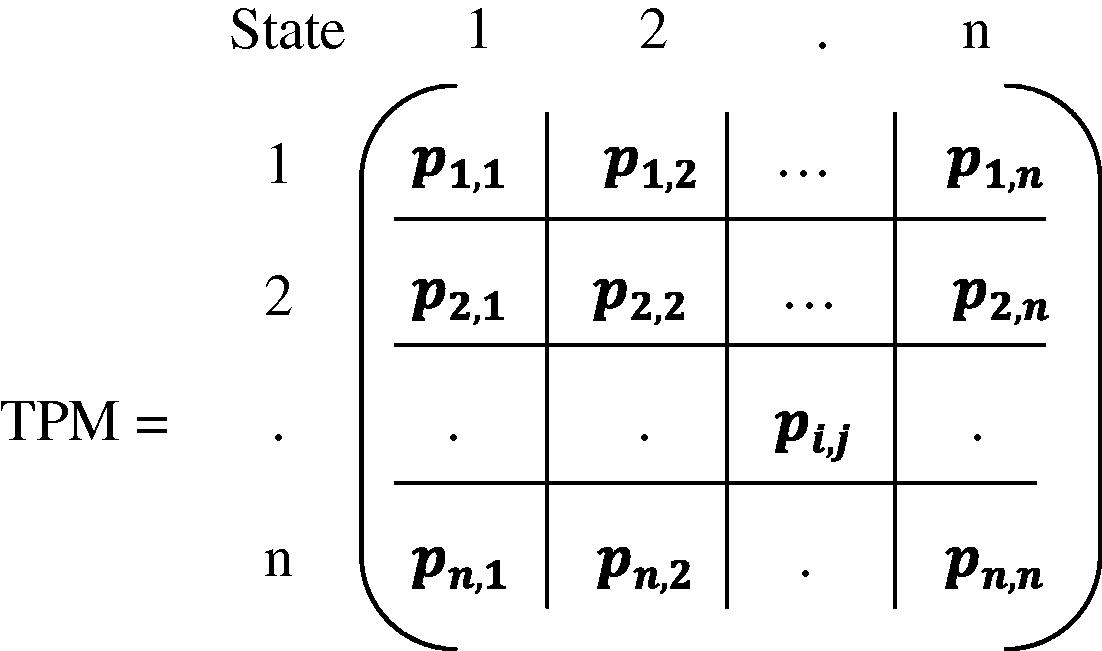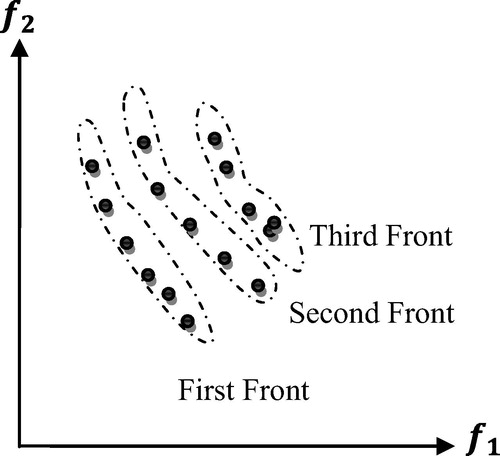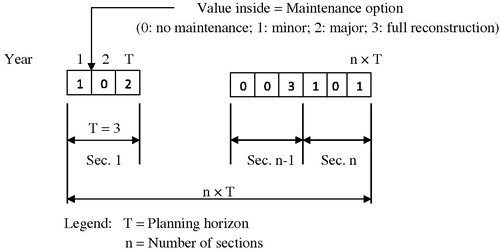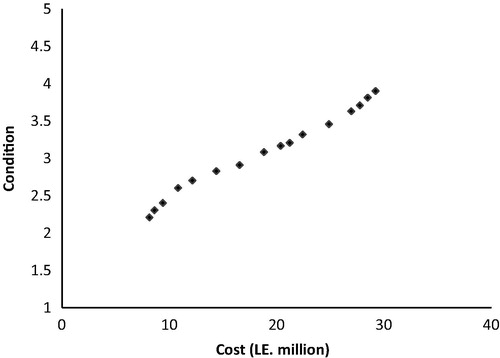 ?Mathematical formulae have been encoded as MathML and are displayed in this HTML version using MathJax in order to improve their display. Uncheck the box to turn MathJax off. This feature requires Javascript. Click on a formula to zoom.
?Mathematical formulae have been encoded as MathML and are displayed in this HTML version using MathJax in order to improve their display. Uncheck the box to turn MathJax off. This feature requires Javascript. Click on a formula to zoom.Abstract
Road network expansion in Egypt is considered as a vital issue for the development of the country. This is done while upgrading current road networks to increase the safety and efficiency. A pavement management system (PMS) is a set of tools or methods that assist decision makers in finding optimum strategies for providing and maintaining pavements in a serviceable condition over a given period of time. A multi-objective optimization problem for pavement maintenance and rehabilitation strategies on network level is discussed in this paper. A two-objective optimization model considers minimum action costs and maximum condition for used road network. In the proposed approach, Markov-chain models are used for predicting the performance of road pavement and to calculate the expected decline at different periods of time. A genetic-algorithm-based procedure is developed for solving the multi-objective optimization problem. The model searched for the optimum maintenance actions at adequate time to be implemented on an appropriate pavement. Based on the computing results, the Pareto optimal solutions of the two-objective optimization functions are obtained. From the optimal solutions represented by cost and condition, a decision maker can easily obtain the information of the maintenance and rehabilitation planning with minimum action costs and maximum condition. The developed model has been implemented on a network of roads and showed its ability to derive the optimal solution.
Introduction
When pavement is in service, the traffic loads and environment would deteriorate it. Therefore, an amount of funds would be invested to maintain it in an adequate condition to perform its role. If available funds are sufficient, the pavement sections whose condition states are below minimum acceptable serviceability level will get maintenance and rehabilitation in time. However, lack of funding often limits timely repairs and rehabilitation of the pavement. Therefore, the decision making of pavement management is the problem on how to gain maximum condition with minimum costs [Citation1]. In many real-life problems, objectives under consideration conflict with each other, and optimizing a particular solution with respect to a single objective can result in unacceptable results with respect to other objectives. A reasonable solution to a multi-objective problem is to investigate a set of solutions, each of which satisfies the objectives at an acceptable level without being dominated by any other solution [Citation2].
While the selection and prioritization of roads can be considered a network-level decision, selection of repair methods for individual roads and their components can be considered as a project-level decision. In the literature, various systems have been developed to support either project-level or network-level decisions, and to a lesser extent, to support both of them. Despite both the network-level and project-level decisions being inter-related, most pavement management research has dealt with them as separate aspects, thus leading to neither being optimally decided. At the network-level, Fwa and Chan [Citation3] developed a repair strategy of pavement considering two objectives for a network level over a planning horizon of 20 years. At the project level, on the other hand, Chikezie et al. [Citation4] presented a project level pavement maintenance and rehabilitation programming problems, focus is mainly on selecting the repair method (e.g., 0: no action, 1: crack sealing, 2: pothole patching, and 3: rehabilitation for a selected road). In this case, details on the specific repair method, cost, and expected improvement are considered.
Over the year there have been successful applications and implementations of multi-objective optimization problems using genetic algorithms. Morcous and Lounis [Citation5] presented an approach for programming maintenance alternatives for a network of infrastructure facilities. This approach uses genetic algorithm optimization techniques to resolve the computational complexity of the optimization problem and Markov chain performance prediction models to account for the uncertainty in infrastructure deterioration. The proposed approach was applied to schedule the maintenance activities of concrete bridge decks protected with asphaltic concrete overlay. Optimizing the resurfacing interventions on flexible pavements was proposed by Bosurgi and Trifiro [Citation6]. The optimization problem was faced by programming a genetic algorithm that manages the decisional process on the basis of two indicators, referring respectively to the sideway force coefficient of pavement and to predicted accidents. In another work, Chootinan and Chen [Citation7] introduced a multi-year pavement maintenance programming methodology that accounts for uncertainly in pavement deterioration. This is accomplished with the development of a simulation-based genetic algorithm approach that is capable of planning the maintenance activities over a multi-year planning period, they also considered the pavement distress deterioration model, but did not go beyond maintenance level.
Multi-objective evolutionary optimization algorithm aims at reducing overall substation cost and improving reliability was introduced by Yang and Chang [Citation8]. Decision-varying Markov models relating the deterioration process with maintenance operations are proposed to predict the availability of individual component. In another work, the reliability-based optimization models for scheduling rehabilitation actions for flexible pavements are presented by Deshpande and Damnjanovic [Citation9]. Three models are presented: minimizes the cost where the target reliability is set as a constraint; maximizes the cumulative life-cycle reliability where the budget is set as a constraint; and minimize cost and maximize reliability. Chikezie et al. [Citation10], for example, developed a model that considers distress deterioration functions using genetic algorithms which invariably determines the warning levels for maintenance interventions. The developed model considers rehabilitation actions for the proposed work. Another example, Gao et al. [Citation11] discussed how to efficiently and completely solve a bi-objective pavement maintenance and rehabilitation-scheduling problem, which aims at optimizing two objectives of pavement condition improvement and budget utilization in a simultaneous manner. A parametric method is suggested to solve the bi-objective pavement maintenance and rehabilitation-scheduling problem. They used a performance comparison between the widely used weighting method and the parametric method that clearly justifies the computational advantages of the parametric method. In another work, Marzouk et al. [Citation12] introduced the developments made in a stochastic performance prediction model and optimization model as two major parts of an integrated pavement management system. Markov modeling is used to predict pavement condition with the use of pavement condition index (PCI). The genetic algorithm technique is adopted to build optimization model. Three objective functions are constructed for minimizing budgeted cost of maintenance and rehabilitation program, maximizing the quality of work performed, and maximizing the total percentage of the network area that will be under maintenance and rehabilitation (M&R). They also presented six types of maintenance and rehabilitation programs for achieving these objective functions. This model ensures that maintenance of road network is adjusted to the limits of budgeted cost with maintaining standard quality of performance.
The main objective of this paper is to develop an integrated pavement management system (PMS) that meets the conditions and specifications of Egyptian road networks. The proposed system aims at providing a technique for handling maintenance and rehabilitation programs as a major part in a decision support system at the network level. Other objectives of the study are: introducing a method for optimizing the maintenance and rehabilitation (M&R) decisions using multi-objective genetic algorithms in conjunction with Markov-chain model considering available budgeted cost and road network conditions using pavement condition index (PCI); and developing a computerized tool to facilitate the use of the proposed model. The output of the model is a set of planning strategies for the maintenance and repair throughout the planning horizon.
Component of a pavement management system (PMS) model
The main components of a generalized PMS that incorporates both project-level and network-level decisions are as follows:
| • | Detailed PMS models (time-dependent deterioration, repair cost, and repair-dependent improvement). | ||||
| • | PMS constraints (industry, governmental, political, user defined constraints, project, and network). | ||||
| • | PMS decision support module (user interface, condition assessment and optimization). | ||||
Pavement condition assessment
Several rating systems had been developed to assess the condition of pavements. As shown in , the pavement condition rating used in this paper was developed by the FHWA [Citation13], which uses a scale from 0 to 4 for road elements. It is assumed that pavements are serviceable until the rating reduces to a value of 1 (non-serviceable). Condition ratings are used to describe the existing condition of a pavement. It is considered as the most important phase on which subsequent decisions are based.
Table 1 Pavement condition rating (FHWA).
Deterioration model
A PMS requires a deterioration model that estimates the future decline in pavement condition so that an appropriate rehabilitation strategy can be decided. In this research, one of the most common models, Markovian deterioration model, is used to predict future pavement condition [Citation14]. These models use the Markov decision process that predicts the deterioration of a component by defining discrete condition states and accumulating the probability of transition from one condition state to another over multiple discrete time intervals. Transition probabilities are represented by a matrix of order (n × n) called the transition probability matrix [TPM], Eq. (1), where (n) is the number of possible condition states.
As shown on the top of [TPM], condition states vary from 1 to (n), where state 1 represents new condition, state 2 represents a deteriorated condition, and so on, to state (n) which represents the critical condition.
According to (AASHTO) [Citation15], road network contains several roads and each road consists of several sections. Area of the network is split into four types based on pavement condition rated by pavement condition index (PCI). Therefore, condition of total area of the network is classified as: (1) excellent, (2) good, (3) fair, and (4) poor. The probability transition matrix is resulting from dividing the number of road sections which remained in excellent conditions after one period without applying any maintenance actions to the total section of the road. The other elements are generated based on applying the same rule by comparing the change in condition of sections between two consecutive inspections without performing any maintenance or rehabilitation action. The initial status of the pavement is expressed by the initial vector matrix [IP0] based on values of pavement condition index in the current year. The IP0 matrix is formulated according to Eq. (Equation2(2)
(2) ).
(2)
(2) Where V1, V2, V3 and V4 are the percentage of road segments that are in Excellent, Good, Fair, and Poor conditions, respectively. Given the [IP0], the future condition vector [FPt], after (t) transition periods, can be calculated as given in Eq. (Equation3
(3)
(3) ) [Citation14]:
(3)
(3) where [PS] is the vector of possible states; [PS]T = [1 2 … n]
Cost model
In this paper, four maintenance strategies are used for pavement maintenance and the cost of repair is estimated: no maintenance, minor maintenance, major maintenance, and (full reconstruction). Minor maintenance intended to use overlay asphalt concrete (3 cm). Major maintenance intended to use overlay asphalt concrete (5 cm). The full reconstruction repair option is the extensive repair that requires a complete closure of the pavement to traffic. The costs associated with these repair options are estimated to be, 0.0, 35.0, 60.0, and 110.0 LE/m2, respectively (The General Authority for Roads, Bridges and Land Transport; GARBLT) [Citation16]. The impact of each repair option on the condition of a pavement section is important to be analyzed. As represented by Morcous and Lounis [Citation5], estimated repair improvement is shown in . This table shows that, to raise the pavement status from condition 1 to condition 3, a major maintenance should be selected while to raise it to condition 4, full construction should be selected.
Table 2 Impact of repair option on pavement condition.
Pavement maintenance decisions using genetic algorithms
General
The problem-solving process of genetic algorithms begins with the identification of problem parameters and the genetic representation (i.e. coding) of these parameters. The search process of genetic algorithms for solution(s) that best satisfy the objective function involves generating an initial random pool of feasible solutions to form a parent solution pool, followed by obtaining new solutions and forming new parent pools through an iterative process. The fitness value of each solution is used to determine its probable contribution in the generation of new solutions known as offspring. The next parent pool is then formed by selecting the fittest offspring based on their fitness (i.e. their objective function values). The entire process is repeated until a predetermined stopping criterion is reached [Citation3].
Pareto Front concept
The Pareto Front concept is used to find the set of optimum solutions. A solution belongs to the Pareto set (set of non-dominated solutions) if there is no other solution that can improve at least one of the objectives without degradation of any other objective. illustrates the concept of Pareto-optimality considering two objectives. The feasible region is the region that represents all feasible solutions for all objective functions of the system. These solutions satisfy the system constraints, but the optimal solutions lie on the outer most lower-left edge of the feasible region (in case of minimization). These sets of Pareto-optimal solutions are generally called Pareto Front.
In multi-objective optimization, to measure the fitness of a solution in a given iteration, the Pareto Front sorting may be used. Using the Pareto Front sorting, the set of non-dominated solutions defining the Pareto Front is identified and assigned a rank of one. These solutions are then set apart, and the remaining solutions are compared to identify a new set of non-dominated solutions with a rank of two. This process continues until the entire population is ranked, as illustrated in . A solution with a lower-numbered rank is assigned a higher fitness than that for a solution with a higher-numbered rank. Accordingly, for minimization problem, the fitness of each solution i is calculated by Eq. (Equation4(4)
(4) ) [Citation17].
(4)
(4) Where fitnessi and ranki are the new fitness value and rank number for solution i.
The main goal of the multi-objective optimization process is to achieve a balance between obtaining a well converged and well-distributed set of optimal solutions. The more diverse the solution is, the better informed the decision maker is about the range and the spectrum of the possible solutions.
Solution representation
Implementing the genetic algorithm technique for the problem at hand requires setting the solution representation (called chromosome in GA terminology). Chromosome structure is made of a string of values associated with the problem variables. As shown in , a solution (chromosome) is made up of a string of n × T elements, where n is the number of pavement sections and T is the planning horizon (3 years). Each of the chromosome elements has a value from 0 to 3 corresponding to one of the maintenance strategies (0 = no maintenance, 1 = minor maintenance, 2 = major maintenance, and 3 = full reconstruction).
Objective functions
In this paper, a two-objective function optimization model is considered: (1) minimizing the maintenance and rehabilitation costs; and (2) maximizing the pavement condition. Output from the optimization model is adopted to calculate the values of two objective functions. This objective function aims at minimizing budgeted cost for maintenance works and formulated as follows:(5)
(5) where Ai total area of each section i in square meter; %Pi: percentage of defective area and cik: cost of maintenance of section i using repair option k.
The second objective function aims at maximizing the condition of overall network of roads, as follows:(6)
(6) Where qi the pavement condition index of section i and n: the number of pavement sections.
Implementation and case study
In order to facilitate the use of the proposed model, the model is coded and implemented using Visual Basic with simple and friendly user interfaces. A case study is introduced to test the use of proposed model. The case study data are obtained from GARBLT for five roads within its jurisdiction (). Data include name of the road, road type, whether it is single or double, and length. The status of each road is expressed in pavement condition index (PCI) of each section of the road by applying field inspections for each road section with year of inspection. The input data, also, includes the number of sections for this network (55 sections), area of each section, and defective area (D.A.) of each section as shown in .
Table 3 List of network roads of the case study.
Table 4 Mansoura Tanah road pavement condition index values and related defective areas (GARBLT).
Data between 2010 and 2011 are used to calculate the average Probability Transition matrix (PTM) for the whole network as shown in Eq. (7):
The values in this matrix are the average of the values related to the transition matrix of each road network. These values are obtained from dividing the number of road sections which remained in their current conditions without applying any maintenance by the total number of road sections. The initial vector matrix of each section is calculated based on PCI values, the status of the network in 2011 is used to generate initial vector matrix. shows initial vector matrix for Mansoura–Tanah road sections and related area of each section. The values shown in for section 1, for example, indicate that this section condition is poor, while section 5 is in fair condition. Then vector matrix is generated to provide prediction of network status in the future for the planning horizon.
Table 5 Initial vector matrix for Mansoura–Tanah road sections and related area.
In the first step, the optimization parameters are necessary to be identified. Through a lot of trial calculation, the reasonable parameters are acquired. These parameters are: population size = 100; crossover probability = 0.6; and mutation probability = 0.01. After the solution convergence is achieved, the results of the case study are presented in and and , which include optimal maintenance and rehabilitation strategies in analysis period for four solutions and Pareto optimal solutions of two objective optimization functions.
Table 6 Optimal maintenance and rehabilitation strategies.
Table 7 Average condition and related cost for some Pareto optimum solutions.
Result analysis
From the results shown in and , a set of Pareto optimal solutions is obtained, which consists of action costs and average condition. Rehabilitation options are represented using allele values representing a possible maintenance action. As shown in . Mansoura–Tanah road consists of 9 sections from section 1–9. Choosing solution number 1 for example, the maintenance strategies for these road sections in year 1 are 0, 1, 0, 0, 0, 0, 0, 0 and 2 which represent no maintenance for sections 1, 3, 4, 5, 6, 7 and 8, perform minor maintenance for section 2, and perform major maintenance for section 9. While in year 2 the maintenance strategies are 0, 0, 1, 0, 2, 0, 2, 3 and 0 which represent no maintenance for sections 1, 2, 4, 6 and 9, perform minor maintenance for section 3, major maintenance for section 5 and 7 and full reconstruction in section 8. While in year 3 the maintenance strategies are 2, 0, 0, 1, 0, 1, 0, 0 and 0 which represent no maintenance for sections 2, 3, 5, 7, 8 and 9, perform minor maintenance for sections 4 and 6 and major maintenance for section 1.
The information presented in and and is of great value to decision makers. The pavement manager can deal with the maximum condition under a certain budget constrain. For example, if the fund to invest during the analysis period is 28,000,000 LE, a maximum condition of 3.707 would be produced under this fund level. The pavement manager can also learn about how much the fund they should invest in the analysis period based on the maximum desired condition of the road network. For instance, if the decision maker wants to keep the maximum condition of this network not below 3.901, the total cost they should invest in the analysis period is no less than 30,000,000 LE.
Conclusions
This paper focused on providing a decision support system for pavement management as one of the most important types of infrastructure management. A model was proposed to accommodate both network level and project level needs. The model searched for the optimum maintenance actions at adequate time to be implemented on an appropriate pavement. Markov chain model is used for predicting status of pavement along its service life. A two-objective genetic algorithm optimization model which considers maximum condition and minimum action costs is used. Based on the computing results, the Pareto optimal solutions of the two-objective optimization functions are obtained. Field data obtained from the General Authority for Roads, Bridges and Land Transport (GARBLT) were used to develop the average transition probability matrix that represents the deterioration of the whole network. In order to facilitate the use of the proposed model, the model is coded and implemented using Visual Basic with simple and user friendly interfaces. A case study is presented to demonstrate the capability of the proposed model in tackling the complex pavement management problems. The optimal solutions of this two-objective optimization model provide the decision makers with the maintenance and rehabilitation planning with maximum condition and minimum action costs.
Conflict of interest
None declared.
Notes
Peer review under responsibility of Housing and Building National Research Center.
References
- J.W.JianJ.K.YongF.ZhiMulti-objective optimization for pavement maintenance and rehabilitation strategiesInt. Conf. Transp. Eng.4200929192924
- A.KonakW.DavidE.SmithMulti-Objective Optimization using genetic algorithmsReliab. Eng. Syst. Saf.9120069921007
- T.F.FwaW.T.ChanMultiobjective optimization for pavement maintenance programmingJ. Transp. Eng., ASEC1262000367373
- C.ChikezieS.AbejideA.TaiwoA.KoloMultiobjective optimization for pavement maintenance and rehabilitation programming using genetic algorithmsWorld Scholars Res. Libr.520137683
- G.MorcousZ.LounisMaintenance optimization of infrastructure networks using genetic algorithmsAutom. Constr.142004129142
- G.BosurgiF.TrifiroA model based on artificial neural networks and genetic algorithms for pavement maintenance managementInt. J. Pavement Eng.62005201209
- P.ChootinanA.ChenA multi-year pavement maintenance program using a stochastic simulation-based genetic algorithm approachTransp. Res. Part A402006725743
- F.YangC.S.ChangMulti-objective evolutionary optimization of substation maintenance using decision-varying Markova modelIEEE Trans. Power232008885895
- P.DeshpandeD.DamnjanovicReliability-based optimization models for scheduling pavement rehabilitationComput.-Aided Civ. Infrastruct. Eng.252010227237
- C.ChikezieS.AbejideA.KoloReview of application of genetic algorithms in optimization of flexible pavement maintenance and rehabilitation in NigeriaWorld J. Eng. Pure Appl. Sci.320116876
- L.GaoC.XieZ.ZhangS.WallerNetwork-level road pavement maintenance and rehabilitation scheduling for optimal performance improvement and budget utilizationComput.-Aided Civ. Infrastruct. Eng.272012278287
- M.MarzoukE.AwadM.El-saidAn integrated tool for optimizing rehabilitation programs of highways pavementBaltic J. Road Bridge Eng.72012297304
- FHWA, Pavement Condition Index Distress Identification Manual for Asphalt and Surface Treatment Pavements, Federal Highway Administration, United States Department of Transportation, 1986.
- Butt A.A., Shahin M.Y., Feighan K.J., Carpenter S.H. “Pavement Performance Prediction Model Using the Markov Process”, Transportation Research Record: Journal of the Transportation Research Board, TRB, Washington, D.C., 1987; 1123: 12–19.
- AASHTO, AASHTO Guide for Design of Pavements Structures, American Association of State Highway and Transportation Officials, Washington, D.C., 1993.
- General Authority for Roads Bridges and Land Transport (GARBLT), <http://www.garblt.gov.eg, 2013 (accessed 12.12.13).
- E. Elbeltagi, T. Hegazy, D. Grierson, A new evolutionary strategy for pareto multi-objective optimization, in: Proceedings of the Seventh International Conference on Engineering Computational Technology, Stirlingshire, Scotland, 2010.




